OPEL KARL 2015 Owners Manual
Manufacturer: OPEL, Model Year: 2015, Model line: KARL, Model: OPEL KARL 2015Pages: 217, PDF Size: 4.16 MB
Page 151 of 217
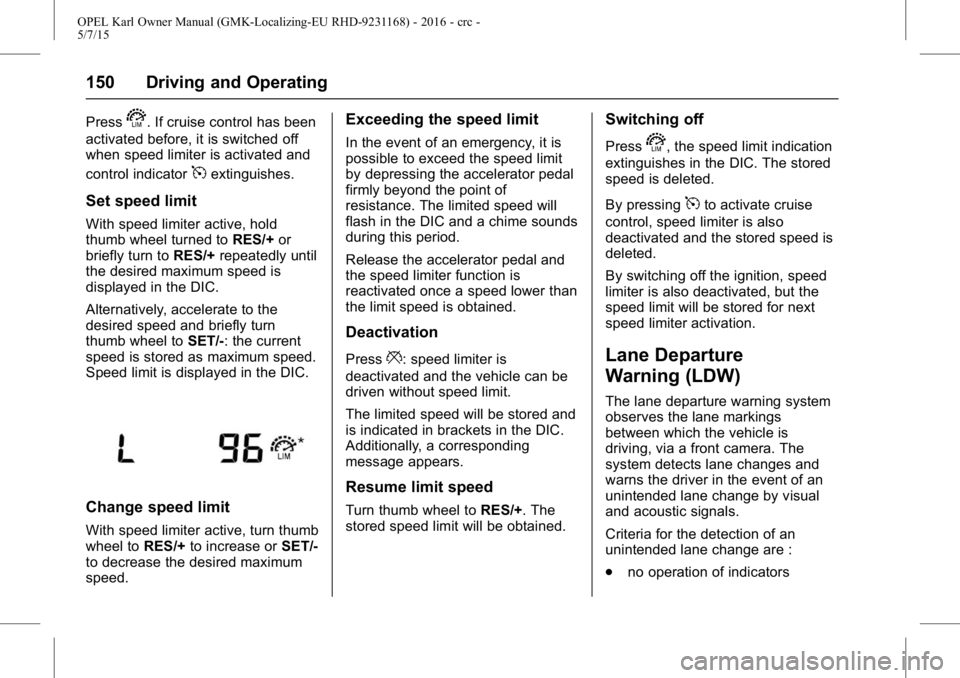
OPEL Karl Owner Manual (GMK-Localizing-EU RHD-9231168) - 2016 - crc -
5/7/15
150 Driving and Operating
Presss. If cruise control has been
activated before, it is switched off
when speed limiter is activated and
control indicator
5extinguishes.
Set speed limit
With speed limiter active, hold
thumb wheel turned to RES/+or
briefly turn to RES/+repeatedly until
the desired maximum speed is
displayed in the DIC.
Alternatively, accelerate to the
desired speed and briefly turn
thumb wheel to SET/-: the current
speed is stored as maximum speed.
Speed limit is displayed in the DIC.
Change speed limit
With speed limiter active, turn thumb
wheel to RES/+to increase or SET/-
to decrease the desired maximum
speed.
Exceeding the speed limit
In the event of an emergency, it is
possible to exceed the speed limit
by depressing the accelerator pedal
firmly beyond the point of
resistance. The limited speed will
flash in the DIC and a chime sounds
during this period.
Release the accelerator pedal and
the speed limiter function is
reactivated once a speed lower than
the limit speed is obtained.
Deactivation
Press*: speed limiter is
deactivated and the vehicle can be
driven without speed limit.
The limited speed will be stored and
is indicated in brackets in the DIC.
Additionally, a corresponding
message appears.
Resume limit speed
Turn thumb wheel to RES/+. The
stored speed limit will be obtained.
Switching off
Presss, the speed limit indication
extinguishes in the DIC. The stored
speed is deleted.
By pressing
5to activate cruise
control, speed limiter is also
deactivated and the stored speed is
deleted.
By switching off the ignition, speed
limiter is also deactivated, but the
speed limit will be stored for next
speed limiter activation.
Lane Departure
Warning (LDW)
The lane departure warning system
observes the lane markings
between which the vehicle is
driving, via a front camera. The
system detects lane changes and
warns the driver in the event of an
unintended lane change by visual
and acoustic signals.
Criteria for the detection of an
unintended lane change are :
. no operation of indicators
Page 152 of 217
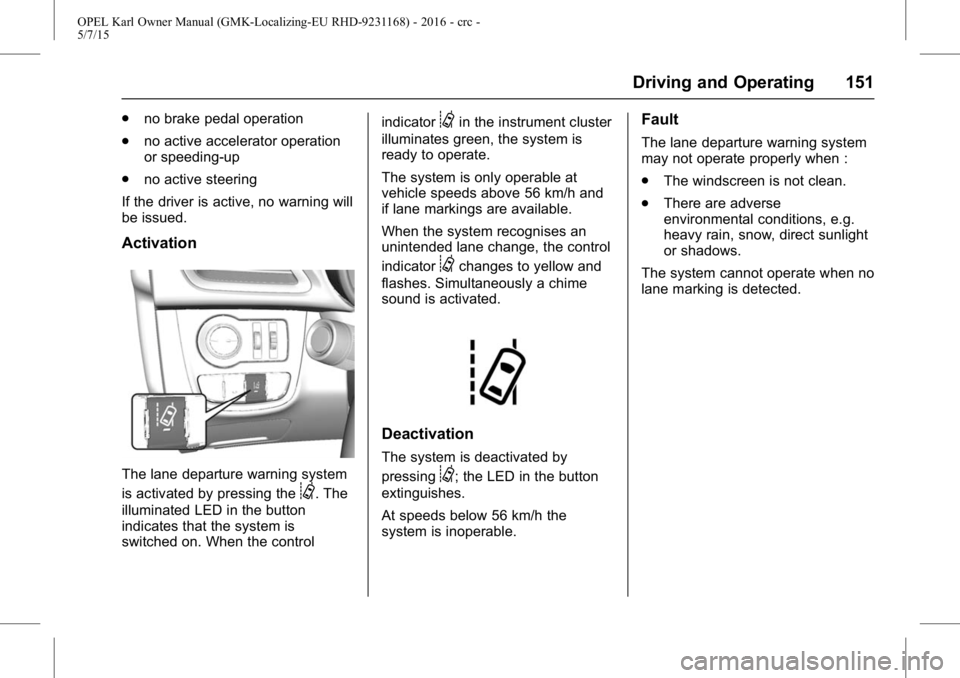
OPEL Karl Owner Manual (GMK-Localizing-EU RHD-9231168) - 2016 - crc -
5/7/15
Driving and Operating 151
.no brake pedal operation
. no active accelerator operation
or speeding-up
. no active steering
If the driver is active, no warning will
be issued.
Activation
The lane departure warning system
is activated by pressing the
@. The
illuminated LED in the button
indicates that the system is
switched on. When the control indicator
@in the instrument cluster
illuminates green, the system is
ready to operate.
The system is only operable at
vehicle speeds above 56 km/h and
if lane markings are available.
When the system recognises an
unintended lane change, the control
indicator
@changes to yellow and
flashes. Simultaneously a chime
sound is activated.
Deactivation
The system is deactivated by
pressing
@; the LED in the button
extinguishes.
At speeds below 56 km/h the
system is inoperable.
Fault
The lane departure warning system
may not operate properly when :
. The windscreen is not clean.
. There are adverse
environmental conditions, e.g.
heavy rain, snow, direct sunlight
or shadows.
The system cannot operate when no
lane marking is detected.
Page 153 of 217
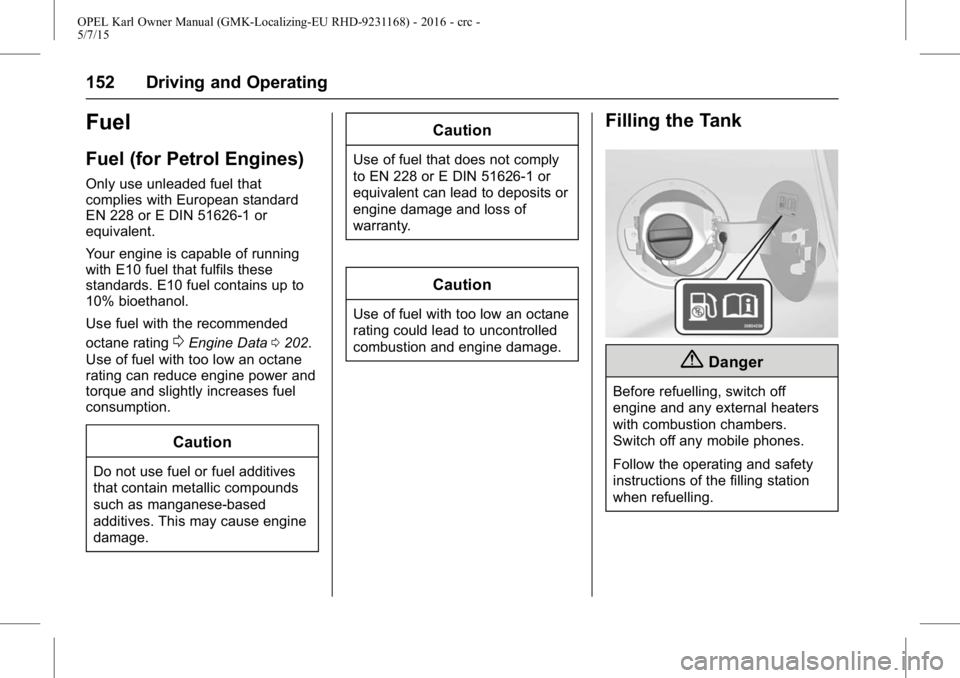
OPEL Karl Owner Manual (GMK-Localizing-EU RHD-9231168) - 2016 - crc -
5/7/15
152 Driving and Operating
Fuel
Fuel (for Petrol Engines)
Only use unleaded fuel that
complies with European standard
EN 228 or E DIN 51626-1 or
equivalent.
Your engine is capable of running
with E10 fuel that fulfils these
standards. E10 fuel contains up to
10% bioethanol.
Use fuel with the recommended
octane rating
0Engine Data0202.
Use of fuel with too low an octane
rating can reduce engine power and
torque and slightly increases fuel
consumption.
Caution
Do not use fuel or fuel additives
that contain metallic compounds
such as manganese-based
additives. This may cause engine
damage.
Caution
Use of fuel that does not comply
to EN 228 or E DIN 51626-1 or
equivalent can lead to deposits or
engine damage and loss of
warranty.
Caution
Use of fuel with too low an octane
rating could lead to uncontrolled
combustion and engine damage.
Filling the Tank
{Danger
Before refuelling, switch off
engine and any external heaters
with combustion chambers.
Switch off any mobile phones.
Follow the operating and safety
instructions of the filling station
when refuelling.
Page 154 of 217
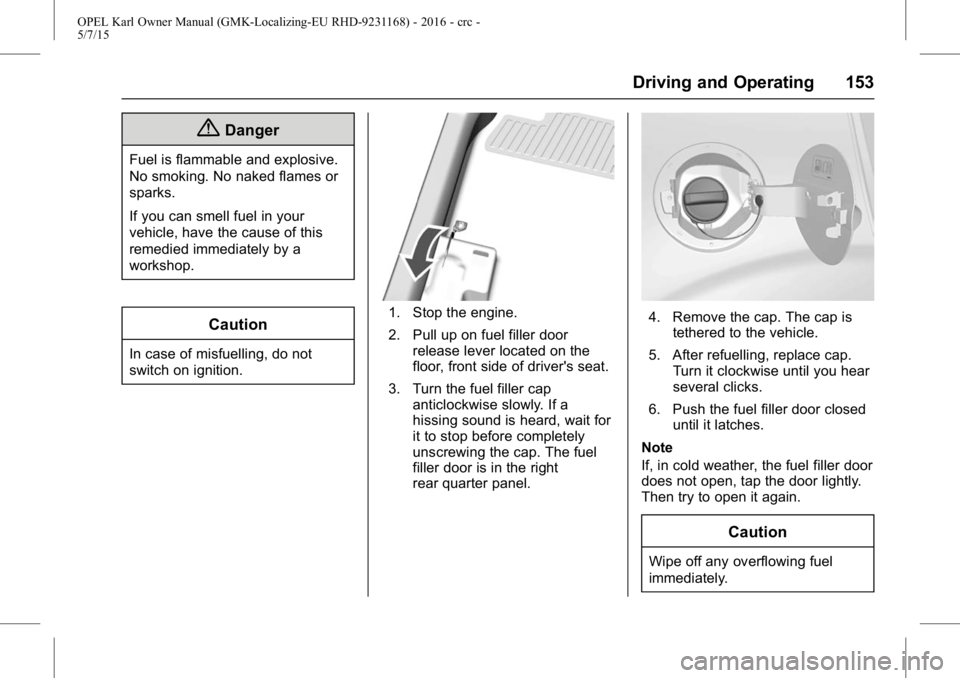
OPEL Karl Owner Manual (GMK-Localizing-EU RHD-9231168) - 2016 - crc -
5/7/15
Driving and Operating 153
{Danger
Fuel is flammable and explosive.
No smoking. No naked flames or
sparks.
If you can smell fuel in your
vehicle, have the cause of this
remedied immediately by a
workshop.
Caution
In case of misfuelling, do not
switch on ignition.
1. Stop the engine.
2. Pull up on fuel filler doorrelease lever located on the
floor, front side of driver's seat.
3. Turn the fuel filler cap anticlockwise slowly. If a
hissing sound is heard, wait for
it to stop before completely
unscrewing the cap. The fuel
filler door is in the right
rear quarter panel.4. Remove the cap. The cap is
tethered to the vehicle.
5. After refuelling, replace cap. Turn it clockwise until you hear
several clicks.
6. Push the fuel filler door closed until it latches.
Note
If, in cold weather, the fuel filler door
does not open, tap the door lightly.
Then try to open it again.
Caution
Wipe off any overflowing fuel
immediately.
Page 155 of 217
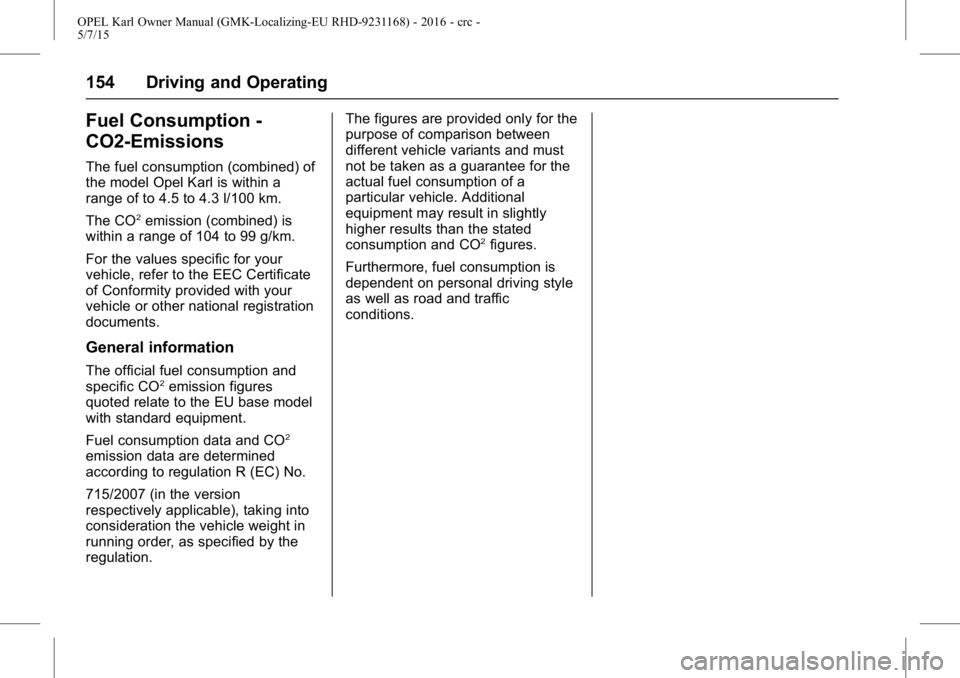
OPEL Karl Owner Manual (GMK-Localizing-EU RHD-9231168) - 2016 - crc -
5/7/15
154 Driving and Operating
Fuel Consumption -
CO2-Emissions
The fuel consumption (combined) of
the model Opel Karl is within a
range of to 4.5 to 4.3 l/100 km.
The CO
2emission (combined) is
within a range of 104 to 99 g/km.
For the values specific for your
vehicle, refer to the EEC Certificate
of Conformity provided with your
vehicle or other national registration
documents.
General information
The official fuel consumption and
specific CO2emission figures
quoted relate to the EU base model
with standard equipment.
Fuel consumption data and CO
2
emission data are determined
according to regulation R (EC) No.
715/2007 (in the version
respectively applicable), taking into
consideration the vehicle weight in
running order, as specified by the
regulation. The figures are provided only for the
purpose of comparison between
different vehicle variants and must
not be taken as a guarantee for the
actual fuel consumption of a
particular vehicle. Additional
equipment may result in slightly
higher results than the stated
consumption and CO
2figures.
Furthermore, fuel consumption is
dependent on personal driving style
as well as road and traffic
conditions.
Page 156 of 217
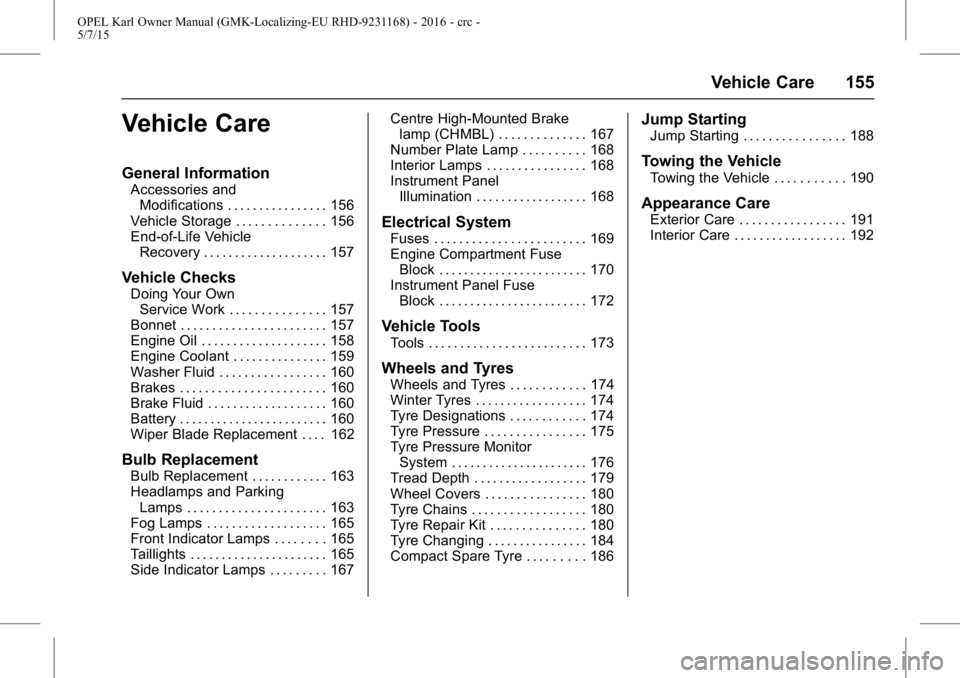
OPEL Karl Owner Manual (GMK-Localizing-EU RHD-9231168) - 2016 - crc -
5/7/15
Vehicle Care 155
Vehicle Care
General Information
Accessories andModifications . . . . . . . . . . . . . . . . 156
Vehicle Storage . . . . . . . . . . . . . . 156
End-of-Life Vehicle Recovery . . . . . . . . . . . . . . . . . . . . 157
Vehicle Checks
Doing Your OwnService Work . . . . . . . . . . . . . . . 157
Bonnet . . . . . . . . . . . . . . . . . . . . . . . 157
Engine Oil . . . . . . . . . . . . . . . . . . . . 158
Engine Coolant . . . . . . . . . . . . . . . 159
Washer Fluid . . . . . . . . . . . . . . . . . 160
Brakes . . . . . . . . . . . . . . . . . . . . . . . 160
Brake Fluid . . . . . . . . . . . . . . . . . . . 160
Battery . . . . . . . . . . . . . . . . . . . . . . . . 160
Wiper Blade Replacement . . . . 162
Bulb Replacement
Bulb Replacement . . . . . . . . . . . . 163
Headlamps and Parking Lamps . . . . . . . . . . . . . . . . . . . . . . 163
Fog Lamps . . . . . . . . . . . . . . . . . . . 165
Front Indicator Lamps . . . . . . . . 165
Taillights . . . . . . . . . . . . . . . . . . . . . . 165
Side Indicator Lamps . . . . . . . . . 167 Centre High-Mounted Brake
lamp (CHMBL) . . . . . . . . . . . . . . 167
Number Plate Lamp . . . . . . . . . . 168
Interior Lamps . . . . . . . . . . . . . . . . 168
Instrument Panel Illumination . . . . . . . . . . . . . . . . . . 168
Electrical System
Fuses . . . . . . . . . . . . . . . . . . . . . . . . 169
Engine Compartment FuseBlock . . . . . . . . . . . . . . . . . . . . . . . . 170
Instrument Panel Fuse Block . . . . . . . . . . . . . . . . . . . . . . . . 172
Vehicle Tools
Tools . . . . . . . . . . . . . . . . . . . . . . . . . 173
Wheels and Tyres
Wheels and Tyres . . . . . . . . . . . . 174
Winter Tyres . . . . . . . . . . . . . . . . . . 174
Tyre Designations . . . . . . . . . . . . 174
Tyre Pressure . . . . . . . . . . . . . . . . 175
Tyre Pressure MonitorSystem . . . . . . . . . . . . . . . . . . . . . . 176
Tread Depth . . . . . . . . . . . . . . . . . . 179
Wheel Covers . . . . . . . . . . . . . . . . 180
Tyre Chains . . . . . . . . . . . . . . . . . . 180
Tyre Repair Kit . . . . . . . . . . . . . . . 180
Tyre Changing . . . . . . . . . . . . . . . . 184
Compact Spare Tyre . . . . . . . . . 186
Jump Starting
Jump Starting . . . . . . . . . . . . . . . . 188
Towing the Vehicle
Towing the Vehicle . . . . . . . . . . . 190
Appearance Care
Exterior Care . . . . . . . . . . . . . . . . . 191
Interior Care . . . . . . . . . . . . . . . . . . 192
Page 157 of 217
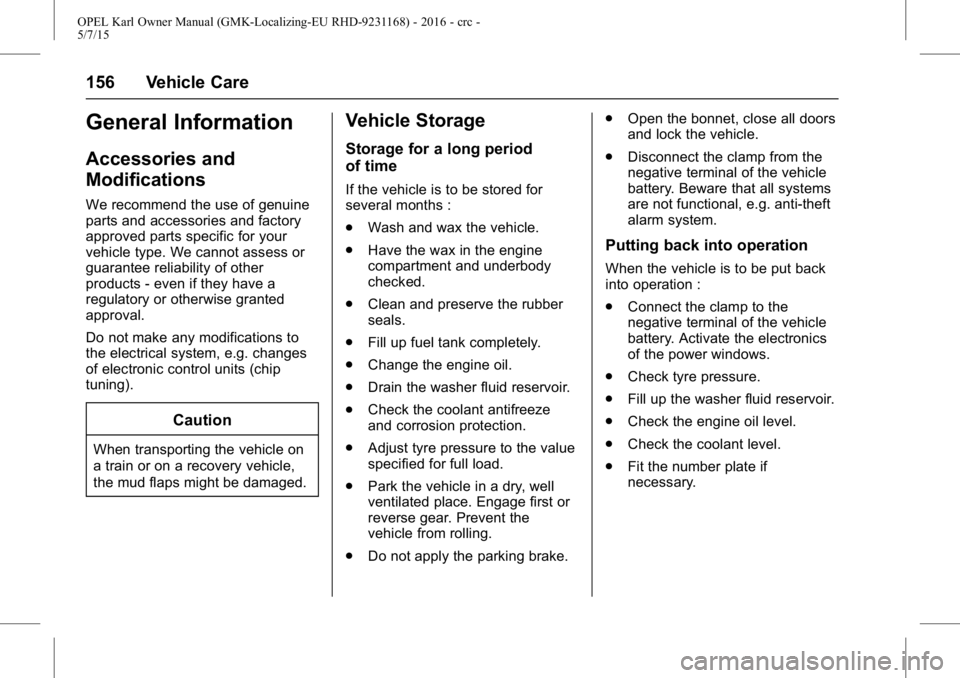
OPEL Karl Owner Manual (GMK-Localizing-EU RHD-9231168) - 2016 - crc -
5/7/15
156 Vehicle Care
General Information
Accessories and
Modifications
We recommend the use of genuine
parts and accessories and factory
approved parts specific for your
vehicle type. We cannot assess or
guarantee reliability of other
products - even if they have a
regulatory or otherwise granted
approval.
Do not make any modifications to
the electrical system, e.g. changes
of electronic control units (chip
tuning).
Caution
When transporting the vehicle on
a train or on a recovery vehicle,
the mud flaps might be damaged.
Vehicle Storage
Storage for a long period
of time
If the vehicle is to be stored for
several months :
.Wash and wax the vehicle.
. Have the wax in the engine
compartment and underbody
checked.
. Clean and preserve the rubber
seals.
. Fill up fuel tank completely.
. Change the engine oil.
. Drain the washer fluid reservoir.
. Check the coolant antifreeze
and corrosion protection.
. Adjust tyre pressure to the value
specified for full load.
. Park the vehicle in a dry, well
ventilated place. Engage first or
reverse gear. Prevent the
vehicle from rolling.
. Do not apply the parking brake. .
Open the bonnet, close all doors
and lock the vehicle.
. Disconnect the clamp from the
negative terminal of the vehicle
battery. Beware that all systems
are not functional, e.g. anti-theft
alarm system.
Putting back into operation
When the vehicle is to be put back
into operation :
.Connect the clamp to the
negative terminal of the vehicle
battery. Activate the electronics
of the power windows.
. Check tyre pressure.
. Fill up the washer fluid reservoir.
. Check the engine oil level.
. Check the coolant level.
. Fit the number plate if
necessary.
Page 158 of 217
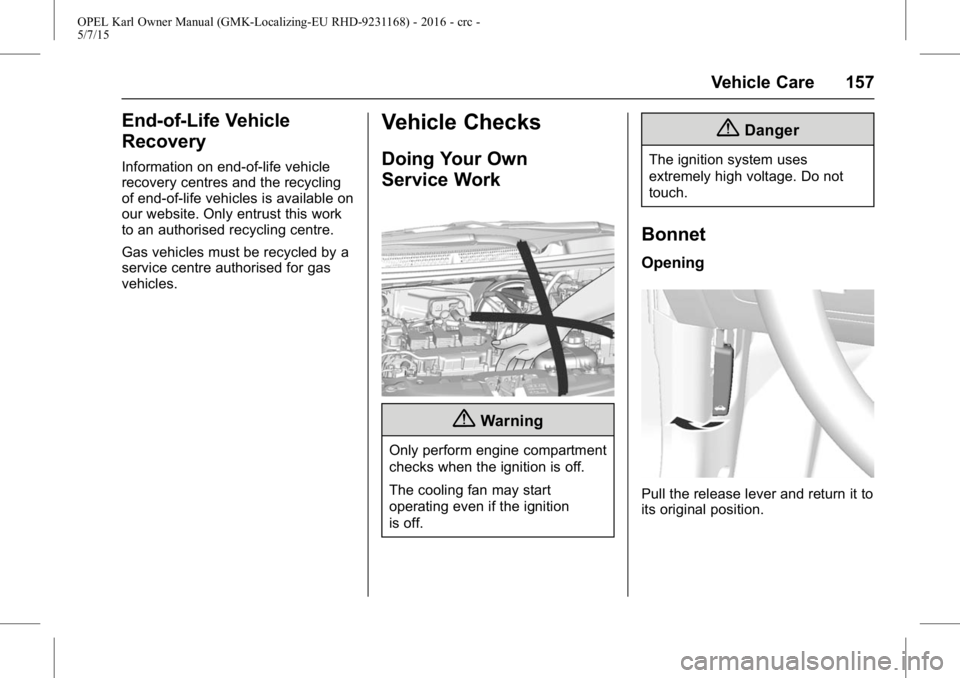
OPEL Karl Owner Manual (GMK-Localizing-EU RHD-9231168) - 2016 - crc -
5/7/15
Vehicle Care 157
End-of-Life Vehicle
Recovery
Information on end-of-life vehicle
recovery centres and the recycling
of end-of-life vehicles is available on
our website. Only entrust this work
to an authorised recycling centre.
Gas vehicles must be recycled by a
service centre authorised for gas
vehicles.
Vehicle Checks
Doing Your Own
Service Work
{Warning
Only perform engine compartment
checks when the ignition is off.
The cooling fan may start
operating even if the ignition
is off.
{Danger
The ignition system uses
extremely high voltage. Do not
touch.
Bonnet
Opening
Pull the release lever and return it to
its original position.
Page 159 of 217
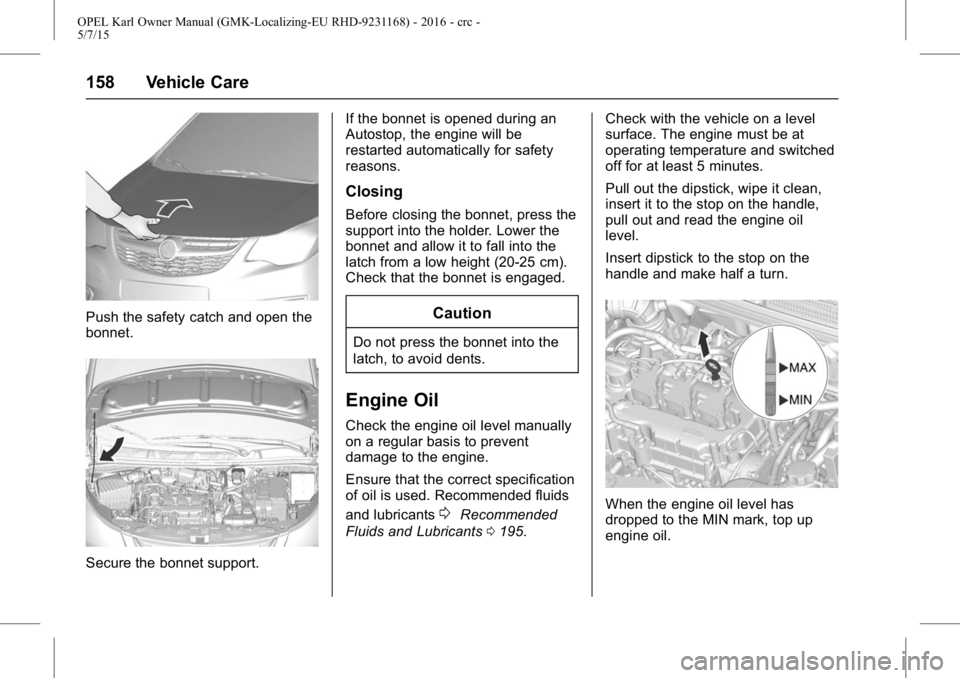
OPEL Karl Owner Manual (GMK-Localizing-EU RHD-9231168) - 2016 - crc -
5/7/15
158 Vehicle Care
Push the safety catch and open the
bonnet.
Secure the bonnet support.If the bonnet is opened during an
Autostop, the engine will be
restarted automatically for safety
reasons.
Closing
Before closing the bonnet, press the
support into the holder. Lower the
bonnet and allow it to fall into the
latch from a low height (20-25 cm).
Check that the bonnet is engaged.
Caution
Do not press the bonnet into the
latch, to avoid dents.
Engine Oil
Check the engine oil level manually
on a regular basis to prevent
damage to the engine.
Ensure that the correct specification
of oil is used. Recommended fluids
and lubricants
0Recommended
Fluids and Lubricants 0195. Check with the vehicle on a level
surface. The engine must be at
operating temperature and switched
off for at least 5 minutes.
Pull out the dipstick, wipe it clean,
insert it to the stop on the handle,
pull out and read the engine oil
level.
Insert dipstick to the stop on the
handle and make half a turn.When the engine oil level has
dropped to the MIN mark, top up
engine oil.
Page 160 of 217
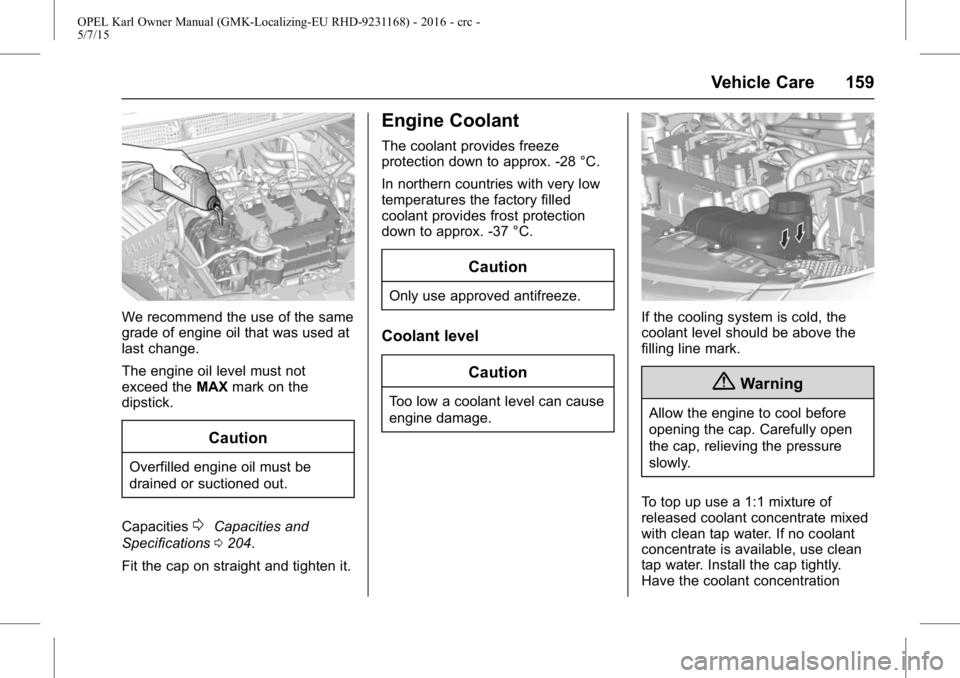
OPEL Karl Owner Manual (GMK-Localizing-EU RHD-9231168) - 2016 - crc -
5/7/15
Vehicle Care 159
We recommend the use of the same
grade of engine oil that was used at
last change.
The engine oil level must not
exceed theMAXmark on the
dipstick.
Caution
Overfilled engine oil must be
drained or suctioned out.
Capacities
0Capacities and
Specifications 0204.
Fit the cap on straight and tighten it.
Engine Coolant
The coolant provides freeze
protection down to approx. -28 °C.
In northern countries with very low
temperatures the factory filled
coolant provides frost protection
down to approx. -37 °C.
Caution
Only use approved antifreeze.
Coolant level
Caution
Too low a coolant level can cause
engine damage.
If the cooling system is cold, the
coolant level should be above the
filling line mark.
{Warning
Allow the engine to cool before
opening the cap. Carefully open
the cap, relieving the pressure
slowly.
To top up use a 1:1 mixture of
released coolant concentrate mixed
with clean tap water. If no coolant
concentrate is available, use clean
tap water. Install the cap tightly.
Have the coolant concentration